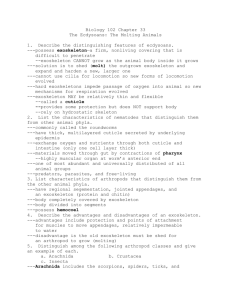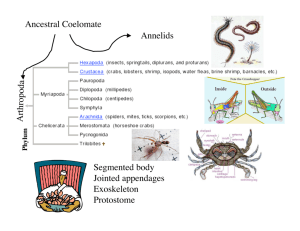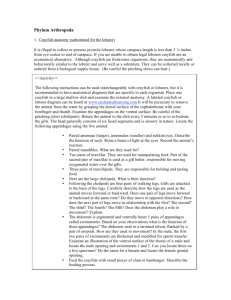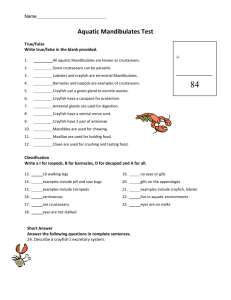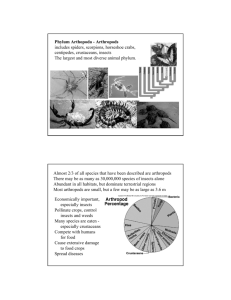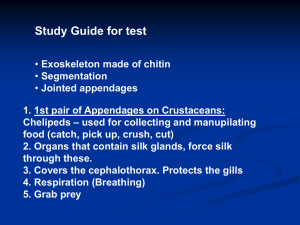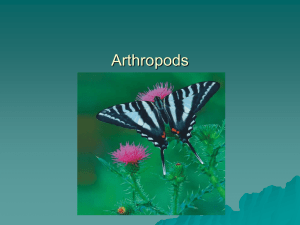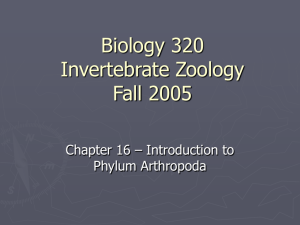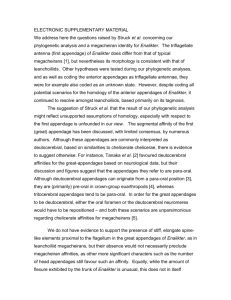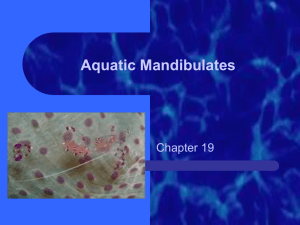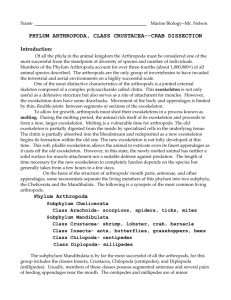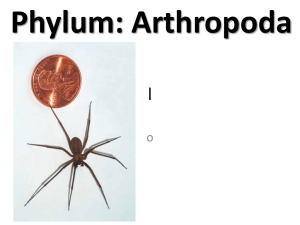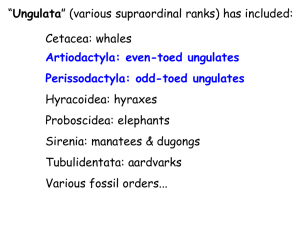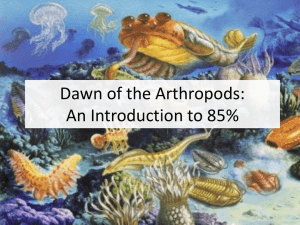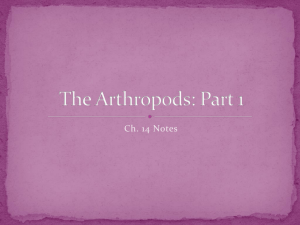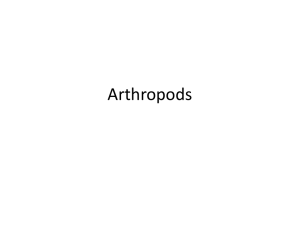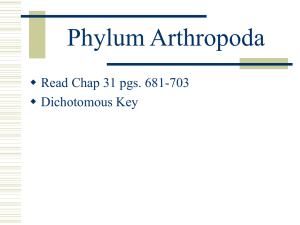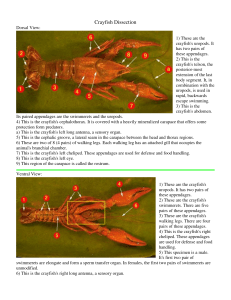The Arthropods:
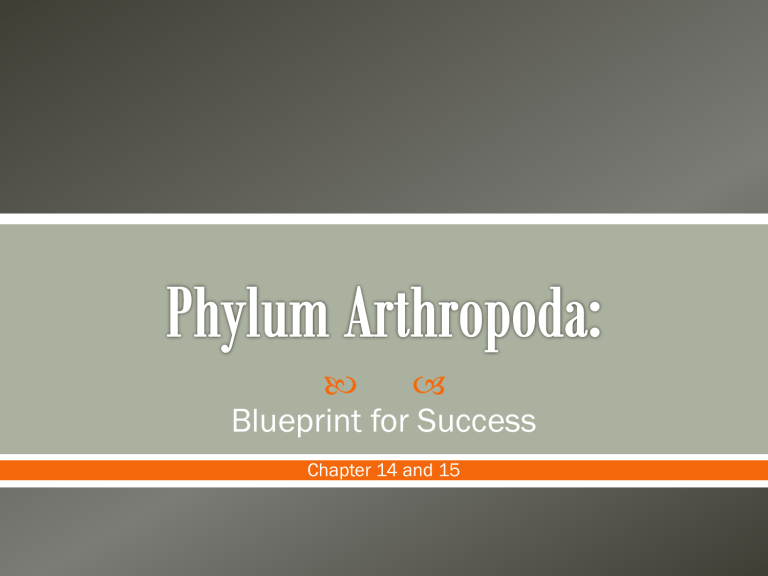
Blueprint for Success
Chapter 14 and 15
Modified segmentation – body regions specialized for specific functions
(tagmatization).
Chitinous exoskeleton used for support and protection
Paired, jointed appendages
Growth accompanied by molting (ecdysis)
Ventral nervous system
Reduced coelom
Open circulatory system where blood is released into tissue spaces (hemocoel)
Complete digestive tract
Metamorphosis often present
Successful in almost all habitats on the earth.
Most abundant animals – Several million species identified o
30 to 50 million species may yet be undescribed
Triploblastic, protostome development
Exhibit bilateral symmetry
Four aspects contribute to arthropod success.
o o
1. Metamerism
2. Exoskeleton o o
3. The Hemocoel
4. Metamorphosis
Segmentation, most evident externally
Each external segment bears a pair of appendages
Body cavity not divided internally
Permits the specialization of regions of the body for specific functions
Regional specialization = Tagmatization o
Body regions (tagmata) specialized for: feeding, sensory perception, locomotion, visceral functions.
External, jointed skeleton which encloses arthropods
Provides support, protection, and prevents water loss
System of levers for muscle attachment and movement
Secreted by epidermal cells o
Epidermis covered by exoskeleton on outside
Consists of two layers: o o
1. Epicuticle = outermost, waxy lipoprotein layer
2. Procuticle/Endocuticle = bulky inner layer made of chitin
Hardening of the procuticle provides armor-like protection
Modifications of the exoskeleton o o o
Formation of joints
Sensory receptors
(bristles, lenses, etc)
Gas exchange
Must be periodically shed for growth
(ecdysis)
Epicuticle and Procuticle: epicuticle exocuticle procuticle endocuticle epidermis
Provides an internal cavity for the open circulatory system of arthropods
Allows for the exchange of nutrients, wastes, and
(sometimes) gases
Indirect development, a significant change in physiology as the immature form becomes an adult
Reduces competition between adults and immature stages
Evolution of arthropods has resulted in an increasing divergence of body forms, behaviors, and habitats between immature and adult stages.
o o
Ex: Larval crabs feed on plankton, adult crabs prowl sandy bottoms for live prey.
Ex: Caterpillar feeds on leafy vegetables, adult butterfly feeds on nectar from flowers.
Examples: o
Crayfish, crabs, lobster, shrimp, barnacles and copepods.
Two unique characteristics: o
1. Two pairs of antennae o
2. Biramous appendages
Five classes of crustaceans and numerous orders o o o o
Class Malacostraca**
Class Maxillopoda**
Class Branchiopoda
Class Remipedia o
Class Cephalocarida
“Soft Shell”
Largest class of crustaceans: o crabs, lobsters, crayfish, shrimp, krill, isopods
Body divided into two regions o o
1. Cephalothorax (fusion of sensory/feeding and locomotion tagmata)
2. Abdomen (a muscular tail)
Paired, biramous appendages in both body regions
Appendages on Cephalothorax : o o o o
Pairs 1 and 2 – Antennae (TWO pairs!)
Pairs 3 through 5 – Mouth appendages
• Mandible Pair (Chewing)
• Maxillae (Food handling)
Pairs 6 through 8 – Maxillipeds
• Accessory sensory and food handling appendages
Pairs 9 through 13 – Pereopods (Walking legs)
• Cheliped (Pincher-like)
Appendages on Abdomen o o
Pleopods (Swimmerets)
Telson used
Reproduction
All crustaceans are dioecious
Mating occurs after molting of the female
In females, developing eggs attach to pleopods and are brooded until hatached
In males, pleopods are modified into claspers and used for sperm transfer
Crayfish have direct development
Feeding
Predators, herbivores, scavengers
Foregut includes an enlarged stomach, specialized for grinding
Midgut = “intestine”
Short hindgut ends in anus and used for water and salt regulation
Gas Exchange & Circulation
Gills in gill chamber o
Between the carapace and body wall
Muscular Heart
Dorsal, anterior, and posterior arteries empty into sinuses of hemocoel
Sensory & Regulation
Ventral nervous system
Compound eyes
Crayfish: Excretion organs are called “green glands”
Other crustaceans: maxillary glands
Includes Barnacles and
Copepods
Copepods are most abundant crustacean o Marine and Freshwater
Barnacles are sessile o o o o
Marine only
Most monoecious
Attach to various substrates
Some are parasitic
